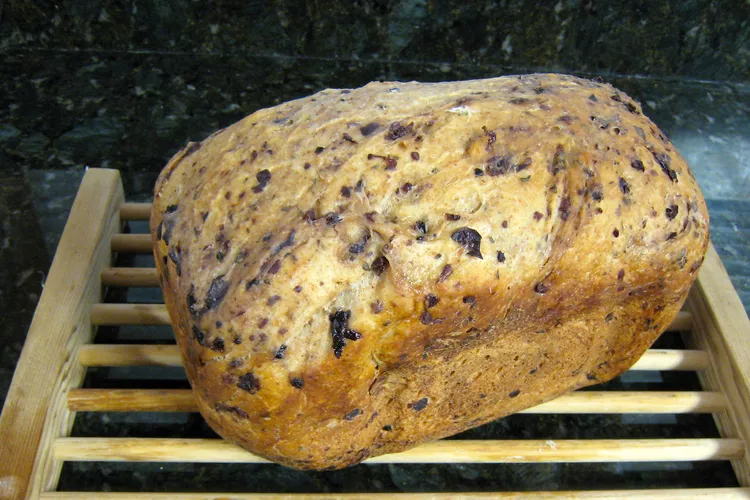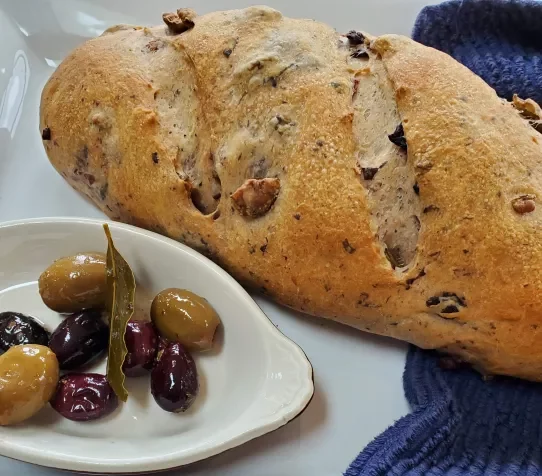Introduction to Olive Bread Recipe
Olive bread Recipe, a staple in Mediterranean cuisine, combines the rustic charm of homemade bread with the rich, tangy flavors of olives. This article delves into the art of making olive bread, guiding you through each step to ensure your loaf is as delightful as those found in the finest bakeries. Whether you’re a seasoned baker or new to the kitchen, this guide will help you create a perfect loaf of olive bread.

The history of bread, as detailed on Wikipedia, shows how integral bread has been to human civilization. Olive bread recipe, with its roots in the Mediterranean, is a delicious variation that has gained popularity worldwide. It’s not just about the taste; the process of baking bread can be a therapeutic and rewarding experience. For more creative ideas on olive bread, Pinterest offers a wealth of inspiration.
In this article, we’ll explore the key ingredients and their roles, provide a step-by-step recipe, discuss variations, and answer frequently asked questions. Let’s embark on this baking journey and discover the joy of making your own olive bread.
Key Ingredients and Their Roles
Creating the perfect loaf of olive bread recipe involves understanding the role of each ingredient:
- Bread Flour: The backbone of many bread recipes, bread flour gives olive bread its chewy texture. For those interested in the science behind it, Wikipedia’s page on bread flour offers more insights.
- Yeast: This is the leavening agent that makes the bread rise. Instant yeast is commonly used for its quick action, but active dry yeast can also be used. Learn more about yeast in baking on Wikipedia.
- Salt: It enhances the flavor of the bread. Coarse sea salt is often preferred for its texture and taste.
- Garlic and Herbs: These add depth and aroma to the bread. Garlic powder and dried oregano are popular choices.
- Olives: The star of the show. Kalamata olives are a popular choice, but feel free to experiment with different varieties. For more on Kalamata olives, check out their Wikipedia page.
- Water: The temperature of the water can affect the yeast’s activity. Room temperature water is ideal for most recipes.
- Optional Cornmeal: Used for dusting, it adds a slight crunch to the crust.
Each ingredient plays a crucial role in creating the bread’s texture and flavor. For those looking to explore different types of bread, Wikipedia’s list of breads is a great resource.
When selecting olives, consider the flavor profile you want. Pinterest has a variety of olive recipes that can inspire your choice. Remember, the quality of your ingredients will significantly impact the final product, so choose wisely.
Step-by-Step Olive Bread Recipe
Making olive bread is a delightful experience. Here’s a step-by-step guide to help you create this savory masterpiece:
- Preparation: Start by gathering all your ingredients. Measure them accurately for the best results.
- Mixing: In a large bowl, combine the bread flour, yeast, salt, garlic powder, and herbs. This mixture forms the base of your dough.
- Kneading: Add the chopped olives and water to the dry ingredients. Knead the dough until it’s smooth and elastic. If you’re new to kneading, Pinterest offers helpful bread baking tips.
- First Rise: Place the dough in a greased bowl, cover it, and let it rise until it doubles in size. This usually takes about 1-2 hours, depending on the room temperature.
- Shaping: Once risen, punch down the dough and shape it into your desired loaf form. This could be a round boule or a traditional loaf shape.
- Second Rise: Allow the shaped dough to rise again, giving it time to develop its final structure.
- Baking: Preheat your oven and bake the bread until it’s golden brown and sounds hollow when tapped. The exact baking time can vary, so keep an eye on your loaf.
For those interested in artisan bread recipes, Pinterest has a collection of artisan bread recipes that can serve as additional inspiration.
Remember, baking is both an art and a science. The more you practice, the better your bread will be. Enjoy the process and the delicious results!
Variations of Olive Bread
Olive bread is versatile, allowing for various tasty variations. Here are some popular ones:
- Green Olive Bread: Swap Kalamata olives with green olives for a brighter flavor.
- Black Olive Bread: Use black olives for a milder taste.
- Rosemary Olive Bread: Add fresh rosemary for an aromatic twist.
- Cheese and Olive Bread: Incorporate grated Parmesan or feta cheese for extra savoriness.
- Sun-dried Tomato and Olive Bread: Mix in sun-dried tomatoes for a sweet and tangy flavor.
Each variation offers a unique taste experience. Experiment with different combinations to find your favorite. For more ideas on bread variations, explore the world of healthy bread recipes on Pinterest.
Tips for Perfect Olive Bread Recipe
To ensure your olive bread turns out perfectly, here are some tips:
- Kneading: Proper kneading develops the gluten, giving the bread its structure. Don’t rush this step.
- Rising: Let the dough rise in a warm, draft-free area. This helps the yeast work effectively.
- Baking: Preheat your oven for a consistent temperature. Use a thermometer to check if the bread is done.
For additional baking advice, Pinterest’s bread baking tips can be very helpful.
FAQs
Can I use active dry yeast instead of instant yeast? Yes, but the rising time may be longer. For every teaspoon of instant yeast, use 1.25 teaspoons of active dry yeast.
Can I make the dough ahead and refrigerate it? Absolutely. This can enhance the flavor and texture of the bread.
Can I make this bread without a stand mixer? Yes, you can mix and knead the dough by hand.
What can I pair with this olive bread? It pairs well with cheeses, cured meats, and Mediterranean dishes like hummus. For more pairing ideas, explore olive recipes on Pinterest.
Serving Suggestions
Serve your olive bread with a variety of accompaniments:
- Cheeses and Cured Meats: A classic choice for a delicious appetizer.
- Dipping Oils and Spreads: Olive oil and balsamic vinegar make a simple yet tasty dip.
- As Part of a Meal: Complement your main dishes with slices of olive bread.
Health Benefits and Nutritional Information
Olive bread is not just delicious; it’s also nutritious. Olives are a good source of healthy fats, and bread flour provides carbohydrates for energy. Enjoy this bread as part of a balanced diet.
Conclusion
We hope this guide inspires you to bake your own olive bread. Remember, baking is a journey of discovery and enjoyment. Happy baking!

